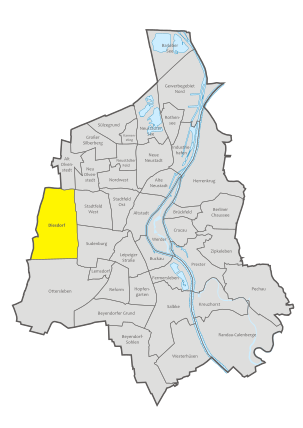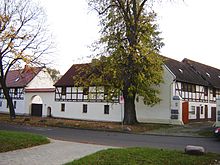Diesdorf (Magdeburg)
|
Diesdorf district of Magdeburg |
|
|---|---|
| Basic data | |
| Surface: | 10.1281 km² |
| Residents : | 3539 |
| Population density : | 349 inhabitants per km² |
| (Information as of December 31, 2016) | |
| Coordinates : | 52 ° 8 ' N , 11 ° 34' E |
| Districts / Districts: | Alt Diesdorf Niederndodeleber Strasse Hohendodeleber Strasse Junkerberg substation |
| Postal code : | 39110 |
| Tram lines : | 6th |
| Bus routes : | 61 72 612 614 663 ( BördeBus ) |
Diesdorf is a district in the west of Magdeburg , the state capital of Saxony-Anhalt . It is 10.1281 km² and has about 3,539 inhabitants (as of December 31, 2016).
location
The Diesdorfer Graseweg / Kümmelsberg road forms the border to the neighboring Stadtfeld West district . The railway line Magdeburg – Braunschweig forms the southern end , while in the north the federal highway 1 separates Diesdorf from the Alt Olvenstedt district . The border to the neighboring district of Börde runs 900 meters west of the development zone . This village is already in the area of the Magdeburger Börde on an area sloping from west to east between 90 and 60 meters above sea level. The small river Schrote flows through the district, which is dammed in the southwest area by a retention basin to hold back floods.
Infrastructure
Today this village is purely a residential area with few commercial settlements. There is a substation in the southern part of the city. Tram line 6 and bus lines 61 and 72 as well as night line N5 end in the Ummendorfer Straße / Am Thie area. This village is also served by the regional bus routes 612, 614, 630 and 663. About a third of the district area is used for agriculture. The cultural monuments in the district are listed in the local monument register .
history
An urn field was discovered near the railway line in 1930, dating from 1000 to 800 BC. Was dated. The place is mentioned for the first time as Thietherestorp in 937 in a document by Otto I on the occasion of the transfer of ownership to the Magdeburg Moritzkloster . While the first part of the historical name refers to a previous owner Dieter, "torp" suggests that the place was founded between 400 and 800 years. In 1350 ownership passed to the Berge monastery , and in the late Middle Ages the Magdeburg Möllenvogtei administered the place. Although the plague epidemics decimated the population in 1348 and 1357 , the construction of the Diesdorf church began around 1350 .
After the Reformation moved into Magdeburg in 1524 , Diesdorf got its first Protestant pastor in 1552 with the Diesdorf farmer's son Steffen Müller. The first school run by the Diesdorf parish began teaching in 1565. During the Thirty Years' War Tilly stationed 1,900 soldiers in Diesdorf in 1630/1631. At the end of the war the village was destroyed except for the church, but by the end of the 17th century it had around 200 inhabitants again. From 1726 there was the Diesdorfer Gesundbrunnen in Diesdorf for a short time , a source believed to be medicinal. When the parish made building land available in 1770, the population grew to over 400 residents. After the Prussian administrative reform of 1815, Diesdorf became part of the Wanzleben district . In 1833 a major fire destroyed seventeen farms. The stately, partly villa-like buildings that emerged afterwards bear witness to the prosperity that resulted from the fertile soil. In May 1897 the volunteer fire brigade, which still exists today, was formed.
With the beginning of industrialization at the end of the 19th century , the character of the place changed from the previous purely agricultural character to a workers' housing estate . Before the First World War , almost 60% of the employees in Diesdorf had a job in Magdeburg. In order to meet Magdeburg's growing demand for electricity, a substation was built near the city limits in the Diesdorf area after the First World War , which has developed into an important hub in the electricity network and is still in operation today. After the Magdeburg urban area had expanded to the border with Diesdorf, it was incorporated into Magdeburg on April 1, 1926. At that time, Diesdorf already had over 3,000 inhabitants. On September 16, 1926, a tram drove to Diesdorf for the first time.
While in the years of GDR rule an LPG continued the agricultural tradition of the place and built a large stable complex and a greenhouse complex in the 1950s, after 1990 there are no more farms in Diesdorf. The Schrote retention basin was built in 1970 , and work began a year later to connect it to the Magdeburg drinking water network, which was completed in 1976.
coat of arms
Blazon : "Diagonally divided by green and red with a silver wave bar on the right, a golden millstone with a free grinding eye at the top, three golden ears of corn on the stalk with leaves set at an angle at the bottom."
The coat of arms of Diesdorf is the first coat of arms of a non-independent district in Germany, which was registered and documented under the registry 1 ST on January 3, 2012 in the German coat of arms of the HEROLD . It was donated by the Bürger- und Heimatverein Diesdorf eV as a symbol of the local and local identity of the former village. The design was done by the municipal heraldist Jörg Mantzsch , who carried out the certification.
literature
- Magdeburg and its surroundings (= values of our homeland . Volume 19). 1st edition. Akademie Verlag, Berlin 1973. DNB 364364106 .
- Georg Dehio: Handbook of German Art Monuments , Saxony-Anhalt I, Magdeburg District , German Art Publishing House , 2002, ISBN 3-422-03069-7 .
- Magdeburg - architecture and urban development. Verlag Janos Stekovics, 2001, ISBN 3-929330-33-4 .
Individual evidence
- ↑ District catalog of the Office for Statistics
- ↑ Diesdorf gets its own coat of arms. on: volksstimme.de , November 23, 2011.
- ↑ Coat of arms for Diesdorf ( Memento of the original from June 7, 2012 in the Internet Archive ) Info: The archive link has been inserted automatically and has not yet been checked. Please check the original and archive link according to the instructions and then remove this notice. on: www.schrotefest.de






